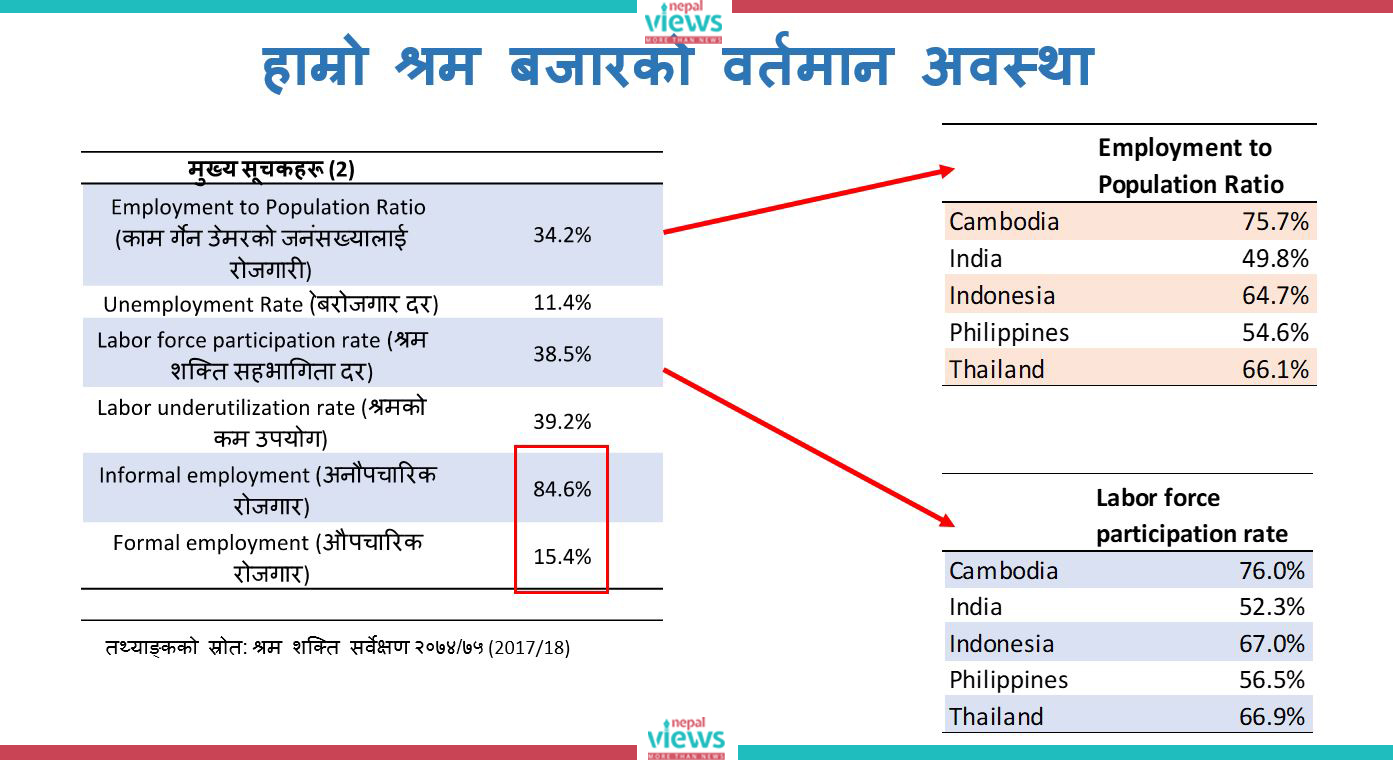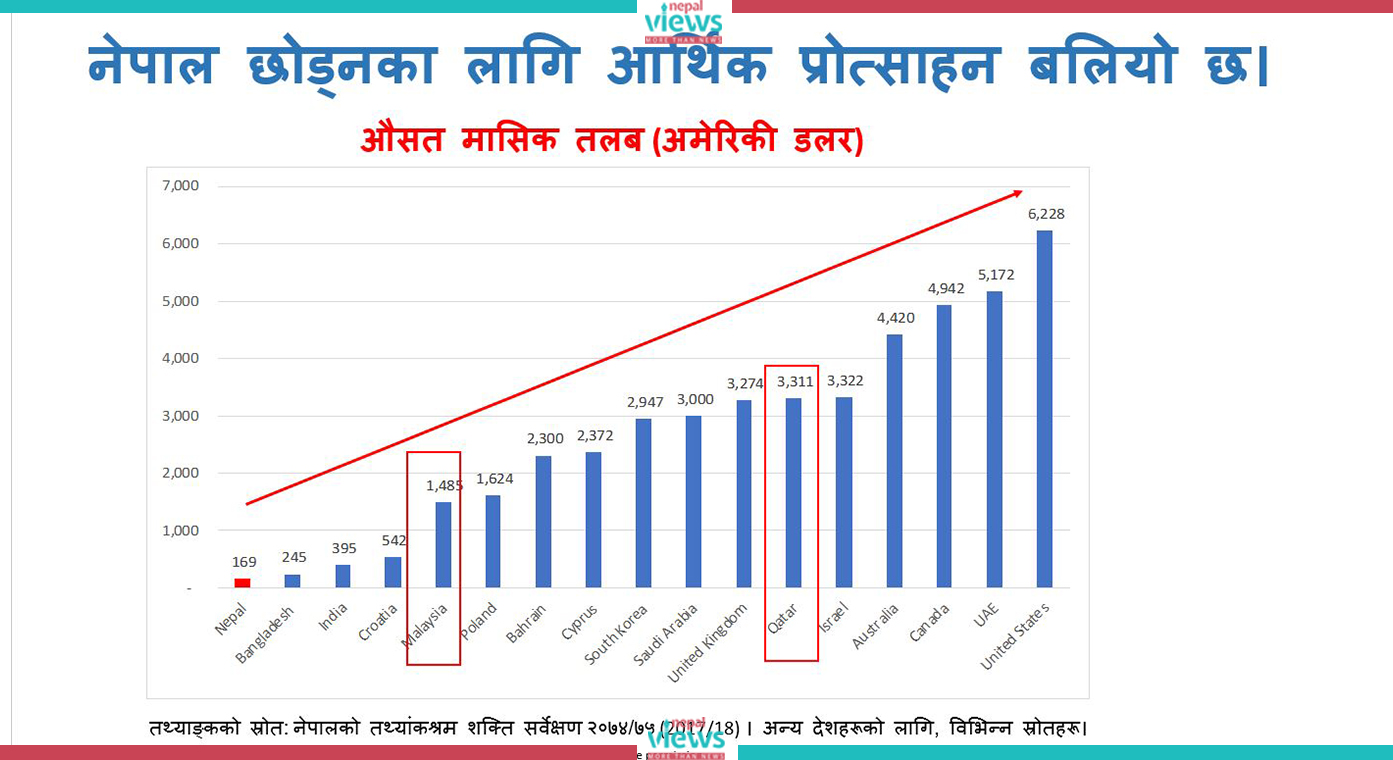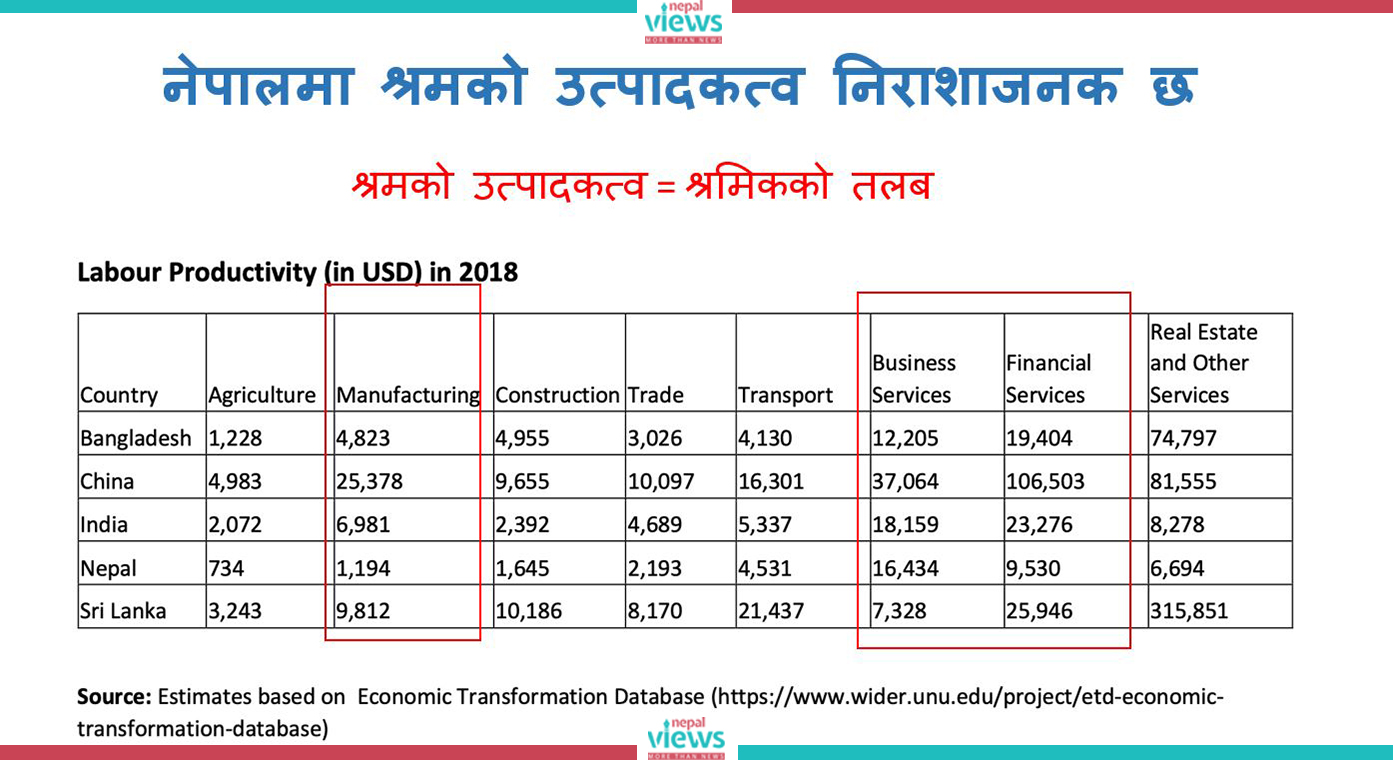Honorable Prime Minister, honorable Finance Minister, fellow panelists, other respected individuals, ladies, and gentlemen.
Let me start by thanking the organizers from Nepal Views for putting together this excellent event to discuss prospects and challenges for Nepal’s economic prosperity.
Many economic issues and challenges can be discussed under this topic of economic prosperity. One easiest way to tell when a nation is prosperous is to look at whether its people are prosperous. People become prosperous when they have decent income that allows them to live comfortable lives. Salaried employment is how most of us earn that income. Wage and salaried employment that is stable, which pays monthly wages, is the kind that most of us want.
I would like to focus today on the main development challenge facing Nepal: the lack of well-paying employment opportunities. Some jobs pay well in Nepal, but they are not nearly enough. I would like to focus my talk today on this issue that is of great importance to our country.
Employment, good employment, decent employment. An average person will experience prosperity only when they have access to good jobs. There are several challenges Nepal faces to create jobs, and there are some concrete solutions that are available.
First, let me start by pointing out that the financial incentives to leave Nepal are very strong. The monthly wage in Nepal is roughly about $169 on average. This data is from the 2074/75 labor force survey. In Nepali RS that year, it was about 17,800.
Now when you look at the place where Nepalis like to go seeking employment opportunities. In Malaysia, the average monthly income is almost 10 times higher than in Nepal. It is at $1,485. In Qatar, it is almost 20 times higher than in Nepal. In the US, it is 40 times higher than in Nepal.
Can you blame young people for wanting to leave? No, you certainly cannot blame them. Financial incentives couldn’t be clearer.
Human beings by their very nature seek better lives. Better tomorrow. Better future for their children. Decent living standard. People have left their homes for thousands of years. This is nothing new, and it is not unique to Nepal.
But, if you ask me: Sameer, are you worried about the recent trends? Yes. I am worried. Because these trends reveal something troubling underneath. The mass exodus of able-bodied, young, and skilled men and women is never a good sign. Nepali policy makers talk about job creation but there is a fundamental and structural disconnect between the desire to create jobs and how to create them. Perhaps we don’t quite understand how we create jobs.
I will get into what creates jobs in a few minutes. But let me show you some headline indicators of the Nepali labor market.
Should you stay in Nepal or should you go abroad?
A young IESE+2 graduate has the option to continue studying or to enter the labor market and start a job. For employment, he or she can work in Nepal or go abroad. If they decide to study, they also have a choice between Nepal and abroad.
What makes a person stay at home given these options? Access to good quality education that has a high probability of landing you a job. That will make a person stay. Job opportunities that pay a decent wage. That will make a person stay in Nepal.
I will not talk much about education, but let me ask you this: how many universities and colleges in Nepal are ranked globally? How many provide high-quality education that is globally marketable? Very few do, and most of these are in medicine and engineering. Even in these fields quality has declined.
Nepal’s working age population is 2 crores 7 lakhs. Out of this, only 79 lakhs are attached to the labor market. The rest of them are out of the labor force. What are these people doing? Some are studying in Nepal, some are studying in foreign countries, some are working in foreign countries, and some are staying idle at home looking to get a visa to go abroad. Our proportion of out of the labor force is large.
In fiscal year 2079-2080, 7 lakhs 75 thousand people left the country for employment abroad. Similarly, one lakh 10 thousand went to study. When you add this up, it is about 7% of people between the ages of 16 and 40.
Our labor market does not provide adequate employment opportunities. There are good jobs in Nepal, in banking, medicine, IT, and finance, but these require higher education. They require high skill. If you look at the recent IESE results, half the people failed these exams. This means there is a large proportion of people who would not have access to high-skill jobs like banking, medicine, IT, and finance.
The employment-to-population ratio in Nepal is 34.2%. This means only one-third of people who are able-bodied to work are working in Nepal. Compare that to other countries like Cambodia, India, Indonesia, the Philippines, and Thailand.

Labor force participation is also very low. Much lower than these countries. Usually, the labor force participation rate should be around 55 to 60%.
The unemployment rate is about 11.4% which is not particularly high. But in Madhesh province, the unemployment rate is over 20%.
Another indicator that is of importance for Nepal is the share of informal employment. This is 84.6%. Think about it for a second – 8 out of 10 people who have a job in Nepal work in the informal sector. An informal job is not a decent job. Salary might not be paid regularly. There is no sick leave. There is no maternity leave.
If a person decides to stay in Nepal, they are more likely to work in the informal sector and make about 17,800 per month. Can you have a decent living standard with that income? Can you raise a family?
Why are the wages low in Nepal? The answer is clear – our labor productivity is dismal. Look at this table. In the manufacturing sector, Nepal’s labor productivity is 1,194 USD. In Bangladesh, it is 4 times more. 4 times more. In India, 6 times more.

If the labor is not as productive, they are not going to earn higher wages. Why is labor not as productive? There could be several reasons. First, firms that employ them do not use modern machinery for production. Second, workers might not be as skilled. Third, the manufacturing sector in Nepal does not produce as many goods to sell in the market, or abroad.
Where are better-paying jobs in Nepal? In business and financial services. if you look at this table, you will see that labor productivity is higher in these sectors. But these are jobs that typically require at least a bachelor’s degree or higher.

How do we create jobs? This simple diagram shows how jobs are created in an economy. When there is higher demand for goods and services, this leads to higher labor demand.
Let’s imagine if every Nepali family decides to buy a solar-powered rice cooker. This increase in demand for rice cookers will lead companies to invest in producing more rice cookers to sell in Nepal. This in turn will lead to increased labor demand in the rice cooker and solar manufacturing sector.
But, you are thinking – Sameer, Nepal does not produce rice cookers. Yes, that is correct. We import them from India, China, and elsewhere. This increase in demand for rice cookers will create jobs even if we are importing, but not enough. Not enough at all. We should require companies to assemble solar-powered rice cookers in Nepal. This will create jobs.
In Nepal, this cycle of job creation has not worked well. Very few goods are produced in Nepal. This needs to change for job creation.
We do create jobs in services. All the restaurants that have come up in Kathmandu and other urban areas in Nepal. They need workers, hence demand labor. But, in these jobs, prospects for higher productivity and pay are much lower. No matter the technology, a job serving momo or tea does not get more productive.
On the other hand, the manufacturing sector job is different. With better technology, you might be able to produce more efficient and cheaper rice cookers. You might be able to produce several times more in a day than you used to in the past. Just look at the modern auto industry. The car industry produces a lot more cars with the same number of people. Their productivity goes up every year. Cat manufacturers have large Research and Design departments. I remember visiting Mahindra’s research and design department in Chennai. It was impressive. They are designing better cars and trucks every year.
How do we increase demand for labor? I have listed 5 ideas but there can be more. You all know these ideas.
1. Commercialization of agriculture
2. Industrialization
3. IT and business services growth
4. Foreign investment
5. Export-oriented industrial policy
Our 5-year plans and budgets have always highlighted these issues. But we fail to implement our ideas. We are good at coming up with ideas, but terrible at implementing them.
Why industrialization? Well, there are a few important reasons. First, it can employ a lot of people. Second, it pays better. Third, with technology, productivity improvements are more likely. This is important for a country’s prosperity. Fourth, infrastructure must be built to transport goods and services. I call this spillover effect.
We need both industrialization and services-led development to create jobs. We need both. But we can start by picking a few key sectors. We can pick winners and support them but fairly and competitively.
On the labor supply side, many of these interventions should be straightforward. First, the quality of primary and secondary education should be better. Second, the quality of higher education should be better. We can allow foreign universities to set up satellite campuses.
If we want to solve our labor market challenge, we need to focus on both the labor demand side and the labor supply side. Many of these strategies can be varied by province.
Let’s focus on creating economic opportunities at home. Let’s raise the quality of our education. When young people see a better future in Nepal, then you don’t need to tell them to stay home. They will. They will stay in Nepal.
If we create adequate employment opportunities, the outflow of people will be less strong. Many will stay home. And many that have left, will come back. But for all this to happen, we need to put our economy on the path to industrialization. We need to compete with countries like Bangladesh and Cambodia. We need to promote agribusiness and services sectors like IT to grow. We will need to make sure that people can earn a decent living with a job. Nepal’s financial sector has done quite well, but I am not sure this has helped the real economy.
Usually, financial development should facilitate and enable economic development by efficient allocation of resources. In our case, finance has done well but perhaps not in the right way. Just look at our dependence on the real estate market. That is for another conversation.
(Based on Dr. Sameer Khatiwada’s presentation in Nepal Views Conclave)














